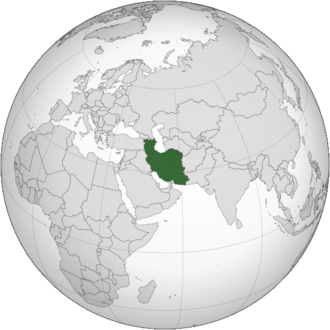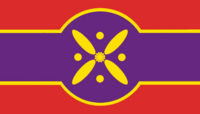Iran (Geopolity): Difference between revisions
No edit summary |
mNo edit summary |
||
| Line 29: | Line 29: | ||
| 2.6% [[Wikipedia:Kurds|Kurds]] | | 2.6% [[Wikipedia:Kurds|Kurds]] | ||
| 2.1% [[Wikipedia:Mazanderanis|Mazanderanis]] | | 2.1% [[Wikipedia:Mazanderanis|Mazanderanis]] | ||
| 2.1%[[Wikipedia:Armenians|Armenians]] | | 2.1% [[Wikipedia:Armenians|Armenians]] | ||
| 1.8% [[Wikipedia:Lurs|Lurs]] | | 1.8% [[Wikipedia:Lurs|Lurs]] | ||
| 1.4% [[Wikipedia:Gilaks|Gilaks]] | | 1.4% [[Wikipedia:Gilaks|Gilaks]] | ||
Revision as of 12:34, 25 April 2024
Note that this Iran is not the same as the Islamic Republic of Iran. This page is a factbook for the Geopolity RP server. Please do not edit this page.
Empire of Iran 𐬌𐬭𐬀𐬥𐬱𐬀𐬵𐬭 (Farsi) Iranšahr | |
|---|---|
Motto: "𐬀𐬥𐬛𐬀𐬱 𐬥𐬀𐬐𐬆, 𐬔𐬎𐬟𐬙𐬀𐬭 𐬥𐬀𐬐𐬆, 𐬐𐬆𐬭𐬛𐬀𐬭 𐬥𐬀𐬐𐬆" (Farsi) (Andaš Nake, Guftar Nake, Kerdar Nake) "Good Thoughts, Good Words, Good Deeds" | |
Anthem: Long Live our Shahanshah | |
 Iran on the globe | |
| Capital and largest city | Rhages |
| Official languages | Farsi in the Avestan alphabet |
| Recognized national languages | Avestan (Liturgical) |
| Recognized regional languages | Azeri, Kurdish, Luri, Gilaki, Mazanderani, Armenian, Turkmen, Arabic, Balochi, Pashto, Tajik, Qashqai, Laki, Suret, Khorasani Turkic, Tati, Talysh |
| Ethnic groups | |
| Religion |
|
| Demonym(s) | Iranian |
| Government | Unitary Parliamentary Constitutional Monarchy |
• Shahanshah (Shahbanu if female) | His Majesty Ardashir VI |
• Wuzurg Framadar | Her Excellency Behdis Gaanjia |
| Legislature | The Imperial Diet |
| The Darbar | |
| The Mehestan | |
| Establishment History | |
| Area | |
• Total | 1,764,538 km2 (681,292 sq mi) |
• Water (%) | 1.1% |
| Population | |
• 2024 estimate | 105,400,000 |
• 2020 census | 103,674,582 |
• Density | 59.7/km2 (154.6/sq mi) |
| GDP (PPP) | 2024 estimate |
• Total | $2.73 trillion |
• Per capita | $25,888 |
| GDP (nominal) | 2024 estimate |
• Total | $852.7 billion |
• Per capita | $8,090 |
| Gini | 33.7 medium |
| HDI | 0.881 very high |
| Currency | Iranian Daric (Ð) |
| Time zone | UTC+3:30 (IRST) [No DST] |
| Date format | dd-mm-yyyy (Z.E.R. and CE) |
| Driving side | right |
| Calling code | +98 |
| Internet TLD | .ir |
Iran, historically known as Persia by Western nations, and officially the Empire of Iran, is a country in West Asia. It is bordered by the Ottoman Empire to the west, Russia to the northwest, the Central Asian Union to the northeast, the Caspian Sea to the north, and the Iranian Gulf to the south, near Arabia. With over 100 million people in an area of 1.76 million sq km (about 680 thousand sq mi), Iran ranks as the 3rd largest nation in the Middle East by both population (behind Egypt and the Ottoman Empire) and largest by area (behind Egypt and Arabia). The nation's capital and most populous city is Rhages, with around 8 million people. Other major cities include Sanabad, Spahan, Baku, Tawres, Fars, Huzaye, Kom, and Hormirzad.
Iran is one of the world's oldest civilizations, beginning with the Elamites in the fourth millennium BC. It was first unified by the Medes in the seventh century BC and reached its territorial height in the sixth century BC, when Cyrus the Great founded the Achaemenid Empire, one of the largest empires in antiquity. Alexander the Great conquered the empire in the fourth century BC, and it was subsequently divided into several Hellenistic states. An Iranian rebellion established the Parthian Empire in the third century BC, which was succeeded in the third century AD by the Sasanian Empire. After resistance to Arab Muslim attempts at a conquest of Iran, culminating in the victorious Battle of Nahavand, the Sasanians ruled the country until the Seljuk and the Mongol conquests of the 11th to 14th centuries. In the 15th century, the native House of Sasan re-established a neo-Sasanian Iran with Zoroastrianism as the official religion, marking the beginning of modern Iranian history.
Under Khosraw XI in the 18th century, Iran was a leading world power, though by the 19th century, it had lost significant influence through a series of conflicts with the Russian Empire. Under the liberal-minded Shahanshahs Peroz VIII and his son Vistahm V, the early and mid-20th century saw a significant shift towards fusing Western ideals such as the abolition of the traditional wuzurgan nobility and powers of the priestly elite, with traditional ideals such as the continued maintenance of Zoroastrianism as the state religion. In 1953, a series of popular protests throughout major cities in support of greater freedoms, combined with the recent election in support of the liberal, center-left Democratic Struggle Party and coalition into power, resulted in the adoption of a new constitution that greatly reduced the powers of the Shahanshah, while greatly expanding the powers of the Imperial Diet and the newly-created High Court in lieu of the mobeds as the judicial branch of the Central Government. The Iranian government is considered one of the most free and fair in the Middle East with its strong democratic traditions following the adoption of the new 1953 Constitution.
Iran is a major emerging, middle and regional power, due to its large reserves of fossil fuels, including the world's largest natural gas supply, third largest proven oil reserves, its large, technologically advanced industrial and financial capability, its business-friendly and entrepreneurial environment, its strategic location in the Asian continent, its military capabilities, its regional influence, and its role as the world's focal point of Zoroastrianism. It is a founding member of the United Assembly of Nations and an observer of the Global Security Association. Owing it to its long history and rich cultural legacy, Iran is home to many hundreds of national treasures, such as the ruins of Persepolis, Golestan Palace, and Nahavand Castle, among other treasured sites. The people of Iran are multicultural and comprise a wide variety of ethnic, linguistic, and religious groups.

